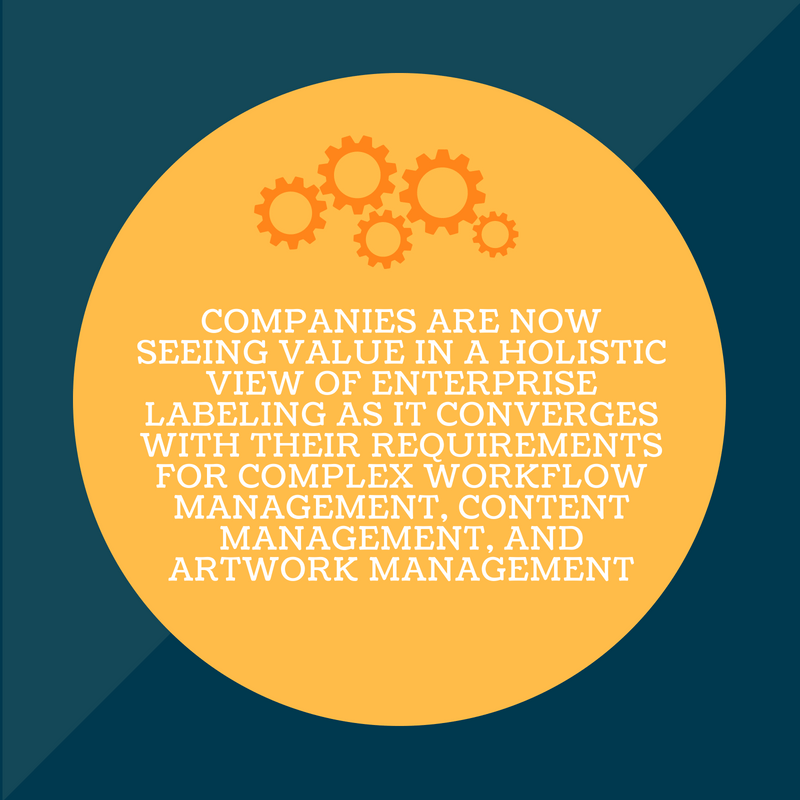Exploring 5 Trends in Enterprise Labeling
Navigating and staying ahead of the curve in the labeling industry can be challenging. There are evolving technologies, regulations and trends to keep in mind. Manufacturing.net recently published a two-part article that explores the challenges within enterprise labeling. Curious about the changes in enterprise labeling? Learn more below.
1. The Definition of Enterprise Labeling is Evolving
Labels are evolving—gone are the days of brief labels. Today, enterprise labeling has the opportunity to offer dynamic date, content and artwork in addition to the necessary required information. Many companies want to ensure that enterprise labeling addresses challenges, and assists with a number of tasks. According to Manufacturing.net, “companies are now seeing value in a holistic view of enterprise labeling as it converges with their requirements for complex workflow management, content management, and artwork management.”
Companies are seeing the value in understanding the connection between content management, workflow, and artwork especially when it comes to the labeling process. These are important things for device and diagnostic professionals to keep in mind.
2. Centralized Control with Continuous Uptime is Imperative
Companies are beginning to understand that the need for centralizing their labeling process and software is crucial to efficiency. Three of the most important requirements companies have are to: centralize their labeling efforts; ensure alignment with corporate standards; allow various geographic locations to run autonomously. When systems and processes are centralized, companies are able to run efficiently, quickly and consistently.
According to Manufacturing.net, “this approach offers the best of both worlds for companies that cannot allow a stop in mission-critical labeling but require greater control and consistency over global labeling.”
3. Analytics is Bringing Improved Visibility into Labeling Processes
There is no denying that companies understand the value of measuring business metrics and analytics. Many companies have used Business Intelligence (BI) to ensure their processes and operations are running efficiently. According to Manufacturing.net, “Our recent survey revealed that although a majority of companies don’t currently have BI for labeling, over 71 percent of $1B+ are interested in leveraging real-time analytics and reporting to help drive improvements to labeling solutions.”
Interactive analysis is an emerging trend in enterprise labeling and allows business to get real-time and specific insights into labeling trends and activities. This allows for businesses to not only see what’s working— but to make process improvements. Manufacturing.net writes, “Users are looking to leverage analytics to drive improvements to labeling processes by asking questions like: Which printers are doing the most work? What labels are being printed the most? What label templates are not being used? How can I gauge the impact of my labeling efforts? Is there a more optimal way to route my print jobs? Who is making label changes? Administrators now want BI to monitor labels printed across facilities to make sure that the quantity of labels printed is in line with the expected output of a facility.”
4. Cloud Technology is Disrupting Labeling
As businesses begin to embrace cloud technology, many labeling manufacturers are doing the same. Manufacturing.net explains that “cloud-based labeling simplifies maintenance and support, reduces cost and IT involvement and expands global use.” SAP, Oracle, Infor, and other enterprise application companies are also beginning to understand how to transition manufacturers to cloud-based systems.
5. Labeling Demands More Attention
Manufacturing.net states, “Labeling has become more complex as companies must meet critical customer and regulatory labeling requirements, while maintaining labeling consistency across multiple markets. This proliferation of customer and regulatory requirements has resulted in more stakeholders getting involved in the labeling process and recently companies have taken strides to establish a dedicated labeling function.”
This means that many departments have become involved in the labeling process, and therefore, the process requires more attention than ever.






